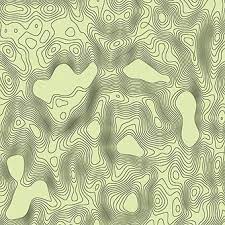The Importance of Contour Lines in The Landscape
The importance of Contour lines in the landscape is important especially if you are a Geography student. It is because the Contour lines are an essential tool for understanding the topography of the land. These lines represent the elevation of the terrain. Moreover, they allow us to visualize the changes in height over a particular area. In this article, we will discuss what contour lines are, how they are created, and their applications.
In this blog, we will examine the various uses of contour lines. It will include topographic mapping, studying elevation changes through time, and creating hiking paths. This blog will give you useful insights into the significance of contour lines, whether you’re a geography enthusiast or a specialist in the subject.
What are contour lines?
Contours are lines on a map that connect points of equal elevation.
They are used to represent the shape of the terrain on a two-dimensional map.
The contour lines themselves are often referred to as isolines, as they separate areas of different elevations.
Moreover, these lines are typically represented as brown lines on topographic maps.
Each line represents a specific elevation, and the distance between lines is constant.
If the lines are too close to each other, it indicates a steeper slope.
Similarly, if the lines are far from each other, the region is flatter.
How are contours created?
Now, a big question arises how these lines are created?
Firstly, these lines are created by taking elevation readings at specific points on the terrain.
Secondly, the points are typically obtained using a surveying instrument called a theodolite.
It can also be obtained through the use of remote sensing techniques such as LiDAR or satellite images.
After that, these elevation readings are used to create a contour map.
Thirdly, the contour map is created by connecting points of equal elevation with contours.
Moreover, the interval between the lines is determined by the scale of the map and the level of detail required.
For example, a large-scale map of a mountainous region might have a contour interval of 20 meters,
while a smaller-scale map of a flatter region might have a contour interval of 5 meters.
Applications of contours
Contours have a wide range of applications.
From navigation to resource management.
Let’s see, some of the most common uses of these lines.
Navigation
Firstly, contours are essential for hikers, mountaineers, and other outdoor enthusiasts.
It tells about the steepness of the terrain, including slope, elevation, and changes in the landscape.
Engineering and construction
Secondly, engineers and architects use contour lines to design structures that are safe and stable.
These lines help determine the best location for a building or structure.
Resource management
Thirdly, people who work in forestry, agriculture, and mining also use the Contours.
This is because these lines provide valuable information about the landscape.
Such information help managers make informed decisions about how to use the land sustainably.
Flood management
Fourthly, one of the uses of these lines is to map flood-prone areas.
With the help of these lines, it is easier to predict potential flood risks.
Moreover, these lines are also used to develop strategies to manage floods and protect communities.
How to read contour lines?
Knowing how to read contours can help you make sense of the landscape and plan your route.
However, these lines are a powerful tool for understanding the terrain and topography of an area.
But if you’re new to contours, they can be a little intimidating at first.
That’s why we’ve put together this guide to help you understand what these lines are and how to read them.
To read contours, there are a few key things to keep in mind:
Contour lines never cross
If you see two contour lines intersecting, it means that there is a cliff or a vertical drop at that point.
Closer lines
Contours that are close together indicate steep terrain.
If these lines are far apart, it means the terrain is relatively flat.
Closed loops or circles
Contour lines that form closed loops or circles indicate hills or mountains.
V shape or a U shape line
Contour lines that form a V shape or a U shape indicate a valley or a depression.
Bending lines
The direction in which the lines bend indicates the shape of the slope.
If the lines are curved, it means that the slope is convex, while straight lines indicate a concave slope.
Color
Contour lines are always drawn in brown on topographic maps.
If you have an understanding of these basic principles, you can start interpreting contour lines on a map.
Moreover, you can gain a deeper understanding of the terrain.
Why contour lines are important
Contour lines are an essential tool for anyone who needs to understand the topography of an area.
For hikers and backpackers, contour lines can help plan a safe and efficient route through the wilderness.
For geologists and scientists, contour lines can provide valuable information about the formation and history of the landscape.
And for cartographers and mapmakers, contours are the key to creating accurate and detailed maps.
So whether you’re exploring a new hiking trail, studying the geology of a region, or creating a map of your own, understanding how to read
contour lines is an essential skill.
With a little practice, you’ll be able to interpret contours with ease and gain a deeper appreciation for the landscape around you.
Where can Contour Lines Be Used?
Mapping the Topography of a Local Park
In this project, you could use contours to map the topography of a local park or natural area.
You can collect the elevation data using GPS or other methods.
Now, use software such as QGIS to create a detailed contour map of the area.
10 Page Project On Turkey Earthquake: Do You Really Need It? This Will Help You Decide
Analyzing Changes in Elevation Over Time
Another project idea is to use these lines to analyze changes in elevation over time.
You could collect elevation data for a particular area over a period of months or years.
Now, use the data to create a series of contour maps to show how the landscape has changed over time.
Project On Women’s Empowerment: Analyzing Women’s Participation and Representation in Politics
Mapping Flood Risk
Contour lines can also be used to map flood risk in a particular area.
By analyzing elevation data and creating a detailed contour map, you can identify areas that are at risk of flooding and develop strategies to
mitigate these risks.
It can also be used by the Disaster Management team.
Designing Hiking Trails:
If you’re interested in outdoor recreation,
you could use contours to design hiking trails that take advantage of the natural topography of an area.
By analyzing elevation data and creating a detailed contour map,
you can identify areas with steep inclines or other challenging terrains, and design hiking trails that are safe and enjoyable for all skill levels.
Creating 3D Models
Finally, you can use contours to create 3D models of a particular area.
You can easily analyze elevation data and create a detailed contour map,
However, you can create a digital model that accurately represents the topography of the area.
Now use it for a variety of applications, from virtual tours to video game development.
Conclusion
Contour lines are an essential tool for understanding the topography of the land. They provide valuable information about the elevation and slope of the terrain, which can be used for a wide range of applications, from navigation to resource management. Understanding contour lines is a crucial skill for anyone who spends time outdoors, and it is essential for anyone working in fields such as engineering, resource management, or urban planning. The representation of the height and shape of the ground surface using contour lines is a fundamental technique used in geography, geology, and other disciplines.





0 Comments